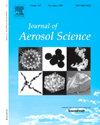人类和大鼠肺泡分布肺部几何形状的发展,以预测呼吸道局部颗粒沉积
IF 3.9
3区 环境科学与生态学
Q2 ENGINEERING, CHEMICAL
引用次数: 0
摘要
吸入给药由于其快速起效和优化给药的潜力,最大限度地减少或消除不良副作用而获得了相当大的关注。递送目标可以是局部的(如呼吸道)或全身的。人们对吸入颗粒在肺部的沉积进行了广泛的研究,现有的模型依赖于简化的假设。然而,这些模型需要改进,以更准确地预测特定地点的沉积模式。在这项研究中,我们将人类和斯普拉格·道利大鼠的传导气道的形态测量数据与两种物种的呼吸单位分布和数量的附加数据结合起来。这使我们能够创造新一代的双路径和特定于肺叶的双路径肺几何形状。与之前的模型不同,这些模型在预先分配的代数上分离了传导气道和呼吸气道,我们提出的几何形状整合了这些通路,在数据支持的情况下将肺泡单位分配给传导气道。基于这些更新的几何形状,开发了一个颗粒沉积模型来预测局部和区域沉积。虽然区域沉积结果与先前的研究一致,但局部(特定地点)沉积预测显着不同,由于传导肺泡气道结构模仿几何真实性,提供了更现实的预测。这些新的几何形状被推荐用于需要准确评估局部沉积的应用,例如靶向药物输送。本文章由计算机程序翻译,如有差异,请以英文原文为准。
Development of alveoli-distributed lung geometries for humans and rats to predict localized particle deposition in the respiratory tract
Inhalation drug delivery has gained considerable attention due to its rapid onset and the potential for optimized delivery, minimizing or eliminating adverse side effects. The delivery targets can be local (such as the respiratory tract) or systemic. Extensive research has been conducted on the deposition of inhaled particles in the lungs, with available models relying on simplifying assumptions. However, these models require improvements to more accurately predict site-specific deposition patterns. In this study, we combined morphometric data for the conducting airways in humans and Sprague Dawley rats with additional data on the distribution and number of respiratory units in both species. This enabled us to create a new generation of 2-path and lobar-specific, 2-path lung geometries. Unlike previous models, which separated the conducting and respiratory airways at a preassigned generation number, our proposed geometries integrated these pathways, assigning alveolar units to the conducting airways where data supported it. A particle deposition model based on these updated geometries was developed to predict both local and regional deposition. While the regional deposition results were consistent with previous studies, the local (site-specific) deposition predictions differed significantly, offering more realistic predictions due to the conducting-alveolar airway structure that mimics geometric realism. These new geometries are recommended for applications that require accurate assessment of local deposition, such as targeted drug delivery.
求助全文
通过发布文献求助,成功后即可免费获取论文全文。
去求助
来源期刊

Journal of Aerosol Science
环境科学-工程:化工
CiteScore
8.80
自引率
8.90%
发文量
127
审稿时长
35 days
期刊介绍:
Founded in 1970, the Journal of Aerosol Science considers itself the prime vehicle for the publication of original work as well as reviews related to fundamental and applied aerosol research, as well as aerosol instrumentation. Its content is directed at scientists working in engineering disciplines, as well as physics, chemistry, and environmental sciences.
The editors welcome submissions of papers describing recent experimental, numerical, and theoretical research related to the following topics:
1. Fundamental Aerosol Science.
2. Applied Aerosol Science.
3. Instrumentation & Measurement Methods.
 求助内容:
求助内容: 应助结果提醒方式:
应助结果提醒方式:


